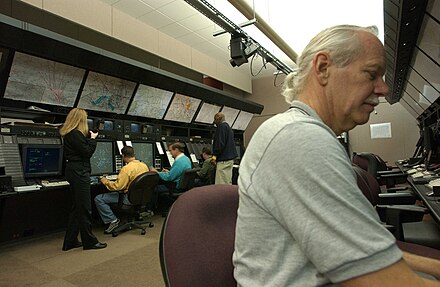


Aeronautical mobile service (short: AMS; also: aeronautical mobile radiocommunication service') is a form of aviation communication conducted through radio. The ITU Radio Regulations divide AMS into communication used for civil air route flights (R) and off-route flights (OR). Aeronautical mobile (R) service is a so-called safety-of-life service, must be protected for interferences, and is an essential part of air traffic control. Communication occurs between radio stations onboard aircraft, termed aircraft stations, and terrestrial stations that are sometimes termed "aeronautical stations". Communication can also occur between aircraft.[1] AMS is commonly used in air traffic control.

Aeronautical mobile satellite service (AMSS) is a form of AMS where an aircraft station is connected to a communications satellite. It is useful in situations where the aircraft is far away from any radio station on land.[2]
The allocation of radio frequencies is provided according to Article 5 of the ITU Radio Regulations (edition 2012).[3]
In order to improve harmonisation in spectrum utilisation, the majority of service-allocations stipulated in this document were incorporated in national Tables of Frequency Allocations and Utilisations which is within the responsibility of the appropriate national administration. The allocation might be primary, secondary, exclusive, and shared.
However, military usage, in bands where there is civil usage, will be in accordance with the ITU Radio Regulations. In NATO countries military utilizations will be in accordance with the NATO Joint Civil/Military Frequency Agreement (NJFA).